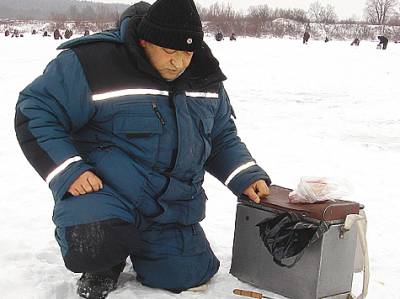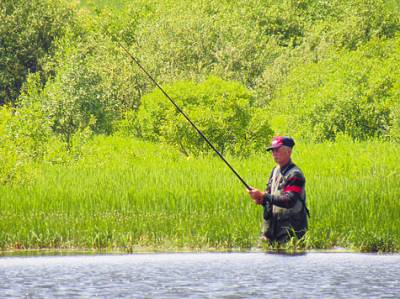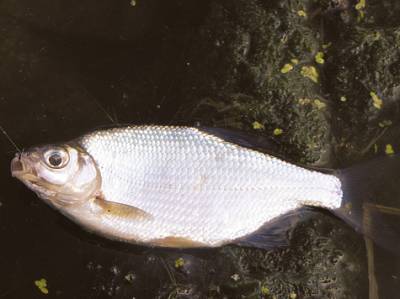
Winter feeding should be made deliberately and intelligently, otherwise it is easy to achieve the effect opposite of the desired effect. First of all should correctly determine the composition of bait that will be effective for the given reservoir in a given time.
To determine feed composition, it is theoretically possible, based on the analysis of the food base of the pond, on the analysis of the behavior of fish in a given time and on the analysis of water. All these factors somehow affect the behavior of the fish’s activity and appetite. Really consider everything fails, because there is no way before each fishing complete analysis of the water and the bottom of the pond only to catch their legitimate five kilos of “weed” fish. Therefore it is necessary to refer to specific patterns, derived from practical observations.
The lakes, especially silty ones, contain large amounts of bottom feed in the form of, for example, bloodworms. In reservoirs with stagnant water, usually a lot of small crustaceans. In rivers many benthic worms and mollusks. Ponds spring type, usually rich in butterfly larvae (Trichoptera), dragonflies, crustaceans and shells.
This may explain the fact that usual for Moscow fish and anglers bloodworm in the bait can “not work” on many of the more remote ponds, and rivers in the Moscow region bloodworm in the bait is not a panacea. Bloodworm is usually perfectly valid when fishing in the coastal zone, where coastal race of small fish familiar with this food. It seems to me that the efficiency of bloodworms in the suburban reservoirs is largely determined by the fact that fish for years been accustomed to a large number of bloodworms in the bait.
On some deep and flowing waters effective as bait can be crackers, cakes and cereals. Some very clear lakes and fast flowing rivers is not valid, none of the baits, or we do not know how to properly apply.
The first conclusion is that the basic composition of the bait defines, but does not imply its effectiveness in a particular reservoir. Every pond requires laborious experiments in order to select the optimal composition. This is true both in summer and winter.
In the winter fish, as cold-water animal, relatively little is moving. And this is connected not so much with a low content of oxygen in the water, but with the fact that all life processes at a low temperature occur more slowly. Fish moving less, spends less energy, less feed. Big fish most of the time now holds Pology. So she’s not looking for food and not bite. In such a situation for fish, especially large ones, becomes sporadic food food, in which the great high-calorie content and light absorption in the components. Optimal base for bait become finely ground breadcrumbs with the addition of milk powder or egg powder. But during the fishing for this bait too quickly eroded, and to hold the fish in place, you have to constantly add new portions. And when the fish are relatively small, a large number of feeding and intensive feeding lead to premature saturation of the fish and, as a consequence, to the absence of a bite or a swift end. The conclusion is that a high calorie bait requires much less in the winter than in the summer in the same pond.
I believe that if the summer for three hours of fishing in the pond without flow enough 3-4 kg of bait based on breadcrumbs, bran and oil cake, in the winter the number should be reduced by approximately seven to ten times. And this is assuming that the fish came on the feed. In winter, more than ever, you can very clearly see that the main purpose of bait is to attract fish, but also to increase her appetite and strengthen the instinct of foraging.
When fishing in stagnant water everything is much easier, even easier than summer. If in the summer the fisherman throws into the water the balls of bait down to the bottom and fall apart, and the angler need not only to achieve a certain decay time of the ball, but also to predict how will be on the bottom spot of bait taking into account bottom currents in the winter and these problems disappear, especially if the depth is small. Complementary feeding at depth has its own characteristics, which actually should focus.
In winter the bait is lowered into the well through the trough just under the hole. A ball of bait, one way or another, soaked with water and fall apart. Still some anglers, due to laziness or due to certain special reasons, abandon the feeders. Or they pour the dry groundbait (mixed with cake crumbs) into the hole or lowered into the hole the balls of bait (both in summer). Such feeding is effective if the depth of capture (but not the depth under the hole) does not exceed two to five meters in the absence of currents.
As an example, fishing for bleak, or roach in Pology. One way or another but the particles of bait thrown into the hole during the fall do not follow strictly vertical trajectory, and the dissipation area. The scattering of bait over the area in a sense, is rationally during the summer fishing, but not in the winter. In the summer there is always the opportunity to do side wiring snap-in and feel “cool” point. In winter there are no such possibilities because the area of harvest is limited by the diameter of the hole, and all the bait that will go beyond the hole, will work against the angler. ( This statement does not apply to cases mastery of winter float rig with a very long leash. But that’s a topic for another conversation.)
Experienced anglers lower the feeder slowly, and before it is open near the bottom, pause, during which the feeder takes the position exactly under the hole. Pause before opening the feeders good and the fact that at this time the bait is completely saturated with water and falls to the bottom not in the form usual for the angler of the ball, but as usual for fish spots. To all quite like “the truth”, it makes sense the bait to disguise under the ground with the aid or component of food (cake, crumbs from the “black” bread), or food coloring, or ballast (earth, sand).
Special case, when the fish reacts to the bait, consisting of steamed hemp or pearl barley. In this case it makes sense to lure not occasionally, depending on the intensity of biting, and a few hours before fishing. To do it better in the evening, in order to keep on lured place active during the night time the big fish, bream specifically.
Fishing on the stream, and during fishing in the pond without flow, you need to keep in mind that the bait should be checked, because from a bad part of the fish can leave, and have to change the place of fishing. For this reason, in order not to risk, I as bait only use a small moth, and in some cases to large. The only component that can optionally be used, so that the land of sand.
There are two options for feeding. The first is that the moth is placed in the feeder and falls to the bottom. The trough is lifted 10-30 cm above the bottom and left in that suspended position. Crank through the holes in the trough gradually crawls out and demolished the course, forming a stream of bait. To crank well and evenly elute, it is necessary to only take pure bloodworms without dust and dirt. The hole from which the fishing is slightly downstream. For reference: at a depth of 6 meters on the Moscow river in Strogino working I drill the hole a meter away from the hole with the feeder.
Feeding the second option is that the balls with the feeders lowered to the bottom, and the working hole is drilled in twenty to thirty centimeters downstream. In this case, there is a risk to be mistaken with the choice of feeding, and the bait may fall dredging, but with this bait (that’s right put on the bottom) can be caught within one or two days.








